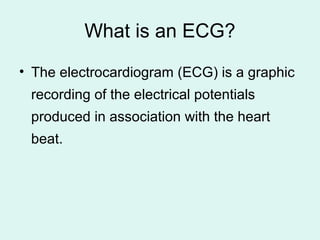
Ecg 1
- 1. What is an ECG? • The electrocardiogram (ECG) is a graphic recording of the electrical potentials produced in association with the heart beat.
- 2. Uses • Chamber hypertrophy • MI • Arrhythmias • Pericarditis • Systemic diseases • Effect of drugs • Electrolyte imbalance
- 3. ECG Graph Paper X- Axis time in seconds Y-AxisAmplitudeinmillvolts
- 5. + + + - - - ECG Bipolar Limb Leads R L F R F L
- 6. • Standard ECG is recorded in 12 leads • Six Limb leads – I, II, III, aVR, aVL, aVF • Six Chest Leads – V1 V2 V3 V4 V5 & V6 • I, II and III are called bipolar leads • I between LA and RA • II between LF and RA • III between LF and LA ECG Bipolar Limb Leads
- 7. ECG Unipolar Limb Leads ++ + Lead aVR Lead aVL Lead aVF R L F
- 8. • aVR, aVL, aVF are called unipolar leads • aVR – from Right Arm Positive • aVL – from Left Arm Positive • aVF – from Left Foot Positive ECG Unipolar Limb Leads
- 10. The Six Chest Leads TRANSVERSE PLANE
- 11. Precordial (chest) Lead Position • V1 Fourth ICS, right sternal border • V2 Fourth ICS, left sternal border • V3 Equidistant between V2 and V4 • V4 Fifth ICS, left Mid clavicular Line • V5 Fifth ICS Left anterior axillary line • V6 Fifth ICS Left mid axillary line ECG Chest Leads
- 12. Precordial Leads
- 14. Other Leads • V7: Posterior Axillary Line • V8: Posterior Scapular Line • V9: Left border of the spine • V3R-9R: Right Sided Leads (V2R = V1) • VE: Ensiform cartilage • E: Esophageal lead
- 15. Pitfalls • Patient Identity • Proper relaxation • Good contact between skin & electrode • Proper Standardization • Properly grounded • Electrical Equipment
- 16. Pacemakers of the Heart • SA Node - Dominant pacemaker with an intrinsic rate of 60 - 100 beats/minute. • AV Node - Back-up pacemaker with an intrinsic rate of 40 - 60 beats/minute. • Ventricular cells - Back-up pacemaker with an intrinsic rate of 20 - 45 bpm.
- 18. Phases of Cardiac Action Potential i) Phase 0: Upstroke or rapid depolarization. (a) Atrial and ventricular muscles and HIS and Purkinje fibres- rapid upstroke and largeVmax. Due to opening of fast Na+ channels. (b) Normal SA & AV node - slow upstroke and reduced Vmax. Due to opening of Ca++ channels.
- 19. ii) Phase 1 : Early rapid repolarization. iii) Phase 2 : Plateau phase. iv) Phase 3 : Final rapid repolarization. v) Phase 4 : Resting membrane potential or diastolic depolarization (-90mv)
- 21. LARA LL ECG Recordings (QRS Vector pointing leftward, inferiorly & posteriorly) 3 Bipolar Limb Leads: I = RA vs. LA (+)
- 22. LARA LL ECG Recordings (QRS Vector pointing leftward, inferiorly & posteriorly) 3 Bipolar Limb Leads: I = RA vs. LA (+) II = RA vs. LL (+)
- 23. LARA LL ECG Recordings (QRS Vector pointing leftward, inferiorly & posteriorly) 3 Bipolar Limb Leads: I = RA vs. LA (+) II = RA vs. LL (+) III = LA vs. LL (+)
- 24. LARA LL ECG Recordings (QRS Vector pointing leftward, inferiorly & posteriorly) 3 Bipolar Limb Leads: I = RA vs. LA (+) II = RA vs. LL (+) III = LA vs. LL (+) 3 Augmented Limb Leads: aVR = (LA-LL) vs. RA(+)
- 25. LARA LL ECG Recordings (QRS Vector pointing leftward, inferiorly & posteriorly) 3 Bipolar Limb Leads: I = RA vs. LA (+) II = RA vs. LL (+) III = LA vs. LL (+) 3 Augmented Limb Leads: aVR = (LA-LL) vs. RA(+) aVL = (RA-LL) vs. LA(+)
- 26. LARA LL ECG Recordings (QRS Vector pointing leftward, inferiorly & posteriorly) 3 Bipolar Limb Leads: I = RA vs. LA (+) II = RA vs. LL (+) III = LA vs. LL (+) 3 Augmented Limb Leads: aVR = (LA-LL) vs. RA(+) aVL = (RA-LL) vs. LA(+) aVF = (RA-LA) vs. LL(+)
- 27. V1 V2 V3 V4 V5 V6 6 PRECORDIAL (CHEST) LEADS Spine Sternum
- 28. ECG Recordings: (QRS vector---leftward, inferiorly and posteriorly 3 Bipolar Limb Leads I = RA vs. LA(+) II = RA vs. LL(+) III = LA vs. LL(+) 3 Augmented Limb Leads aVR = (LA-LL) vs. RA(+) aVL = (RA-LL) vs. LA(+) aVF = (RA-LA) vs. LL(+) 6 Precordial (Chest) Leads: Indifferent electrode (RA-LA-LL) vs. chest lead moved from position V1 through position V6.
- 29. Normal Impulse Conduction Sinoatrial node AV node Bundle of His Bundle Branches Purkinje fibers
- 30. Impulse Conduction & the ECG Sinoatrial node AV node Bundle of His Bundle Branches Purkinje fibers
- 31. The “PQRST” • P wave - Atrial depolarization • T wave - Ventricular repolarization • QRS - Ventricular depolarization
- 32. The PR Interval Atrial depolarization + delay in AV junction (AV node/Bundle of His) (delay allows time for the atria to contract before the ventricles contract)
- 34. ECG Complex • P Wave is Atrial contraction – Normal 0.12 sec • PR interval is from the beginning of P wave to the beginning of QRS – Normal up to 0.2 sec • QRS is Ventricular contraction –Normal 0.08 sec • ST segment – Normal Isoelectic (electric silence) • QT Interval – From the beginning of QRS to the end of T wave – Normal – 0.40 sec • RR Interval – One Cardiac cycle 0.80 sec
- 35. Reporting of ECG 1. Standardization 2. Rhythm 3. Heart rate 4. PR interval 5. QRS interval 6. QT/QTc interval 7. Axis 8. P wave
- 36. 9. Precordial R wave progression 10. Abnormal Q wave 11. ST Segment 12. T wave 13. U wave
